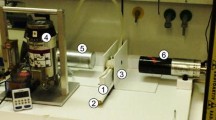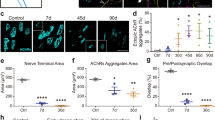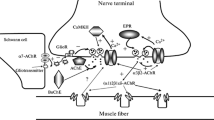Abstract
MOTOR nerves have an important role in the trophic regulation of many properties of skeletal muscle, including acetylcholine receptor (AChR) distribution1. In innervated muscle, the density of AChR at neuromuscular junctions is at least 2,500 times greater than at extrajunctional regions2. When the motor nerves are sectioned, extrajunctional AChR density increases markedly2–5. The trophic mechanisms by which the nerves normally prevent this denervation change are not yet well understood. It has been suggested that muscle use contributes to the control of AChR. This hypothesis has been tested in two ways. First, electrical stimulation was applied directly to denervated muscle, and the extrajunctional ACh sensitivity was determined. The results indicated that stimulation-induced use largely prevented the denervation effect6,7. Second, attempts have been made to assess the effect of disuse of muscle on extrajunctional ACh sensitivity. Various methods have been used to eliminate muscle contraction but all have had shortcomings. In some cases, the ‘disuse’ has been incomplete8–10; in others, the methods used to block nerve conduction7,11 have produced blockade of axonal transport12,13, which may itself result in denervation effects14,15. Using a new model of disuse free of these problems, we have now compared the effects of disuse and denervation with respect to extrajunctional AChR density. We report here evidence that disuse produces a significant increase in extrajunctional AChR, but does not completely reproduce the effect of surgical denervation.
Similar content being viewed by others
References
Harris, A. J., A. Rev. Physiol., 36, 251–305 (1974).
Hartzell, H. C., and Fambrough, D. M., J. gen. Physiol., 60, 248–262 (1972).
Axelsson, J., and Thesleff, S., J. Physiol., Lond., 147, 178–193 (1959).
Lee, C. Y., Tseng, L. F., and Chiu, T. H., Nature, 215, 1177–1178 (1967).
Libelius, R., J. Neur. Trans., 35, 137–149 (1974).
Drachman, D. B., and Witzke, F., Science, 176, 514–516 (1972).
Lømo, T., and Rosenthal, J., J. Physiol., Lond., 221, 493–513 (1972).
Johns, T. R., and Thesleff, S., Acta Physiol. scand., 51, 136–141, (1961).
Fischbach, G. D., and Robbins, N., J. Neurophys., 34, 562–569 (1971).
Vyskocil, F., Moravec, J., and Jansky, L., Brain Res., 34, 381–384 (1971).
Roberts, E. D., and Oester, Y. T., Archs Neurol., 22, 57–63 (1970).
Bisby, M. A., Expl Neurol., 47, 481–489 (1975).
Fink, B. R., Kennedy, R. D., Hendrickson, A. E., and Middaugh, M. E., Anesthesiology, 36, 422–432 (1972).
Hoffman, W. W., and Thesleff, S., Eur. J. Pharm., 20, 256–260 (1972).
Albuquerque, E. X., Warnick, J. E., Tasse, J. R., and Sansone, F. M., Expl Neurol., 37, 607–634 (1972).
Hille, B., J. gen. Physiol., 51, 199–219 (1968).
Fambrough, D. M., J. gen. Physiol., 64, 468–472 (1974).
Berg, D. K., Kelley, R. B., Sargent, P. B., Williamson, P., and Hall, Z. W., Proc. natn. Acad. Sci. U.S.A., 69, 147–151 (1972).
Katz, B., and Thesleff, S., J. Physiol., Lond., 137, 267–278 (1957).
Ochs, S., J. Physiol., Lond., 227, 627–645 (1972).
Griffin, J. W., Price, D. L., Drachman, D. B., and Engel, W. K., Ann. N. Y. Acad. Sci. (in the press).
Thesleff, S., J. Physiol., Lond., 151, 598–607 (1960).
Drachman, D. B., Ann. N. Y. Acad. Sci., 278, 160–176 (1974).
Jones, R., and Vrbova, G., J. Physiol., Lond., 236, 517–538 (1974).
Karnovsky, M. J., and Roots, L., J. Histochem. Cytochem., 12, 219–221 (1964).
Author information
Authors and Affiliations
Rights and permissions
About this article
Cite this article
PESTRONK, A., DRACHMAN, D. & GRIFFIN, J. Effect of muscle disuse on acetylcholine receptors. Nature 260, 352–353 (1976). https://doi.org/10.1038/260352a0
Received:
Accepted:
Issue Date:
DOI: https://doi.org/10.1038/260352a0
- Springer Nature Limited
This article is cited by
-
mTORC1 and PKB/Akt control the muscle response to denervation by regulating autophagy and HDAC4
Nature Communications (2019)
-
Terminal nerve sprouting at the frog neuromuscular junction induced by prolonged tetrodotoxin blockade of nerve conduction
Journal of Neurocytology (1989)
-
Effect of axoplasmic transport blockade on end-plate currents in frog muscle fibers
Neurophysiology (1985)
-
Effect of postsynaptic blockade of neuromuscualar transmission on properties of the frog fast muscle fiber membrane
Neurophysiology (1984)
-
Neuromuscular plasticity following limb immobilization
Journal of Neurocytology (1984)





